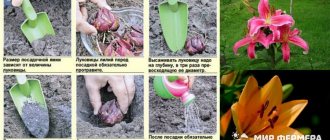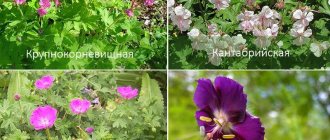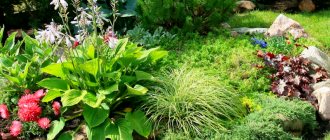If in the spring, when there is no greenery yet, and the grass is just beginning to appear, you see a bush covered with bright yellow small flowers from the base to the crown, this is forsythia, which, like the snowdrop, is considered a symbol of spring. It will bloom for 1.5-3 weeks, after which it will begin to become covered with leaves. After flowering, if gentle pruning is carried out in a timely manner, maintaining the shape of the bush, the plant looks no less decorative - in a composition with flowering and deciduous perennials it looks very harmonious and picturesque. In some varieties, the foliage changes color in the fall, and the shrub looks original until late autumn.
Features of the culture - botanical description
Forsythia, forsythia, forsythia are the names of the same plant belonging to the genus Forsythia from the Olive family. It received the scientific name “Forsythia” in honor of the botanist W. Forsyth, who brought an unfamiliar plant from an expedition to China. Under natural conditions, representatives of the genus are found in the eastern regions of Asia and southeastern Europe.
Many species (13 in total) are cultivated as ornamental beautifully flowering shrubs: F. Giraldiana, F. ovata, F. europaea, F. hanging or drooping (F. suspensa ), F. intermediate (F. intermedia), F. greenest (F. viridissima).
F. Giraldiana
F. ovata
F. europaea
It is difficult to give a general description of forsythia, since each species has its own characteristics, but there are still common characteristics. Depending on the species and place of growth, representatives of the genus can be shrubs, low trees (1-3 m in height) with a volumetric crown with a diameter of 2-2.5 m. Erect or arched shoots quickly become lignified and covered with hard grayish-brown bark.
The leaves (length 3-15 cm) begin to grow after flowering; more often they are simple, oval in shape, with a smooth edge, sometimes with small teeth, but in some species, for example, F. intermedius, the leaves are trifoliate. There are hybrids and varieties with purple, variegated leaf color - the “Spectabilis” variety turns yellow-violet with the onset of cold weather, and the “Weekend Sapphire” variety turns purple.
Spectabilis
Weekend Sapphire
It begins to bloom after the snow melts, the flowering duration is 10-20 days. The bare stems along their entire length are strewn with bright flowers of various shades of yellow, similar in shape to a bell. It is pollinated by insects, after which a fruit-box with winged seeds is formed.
With proper care, forsythia grows in one place for up to 50 years. Low (up to 100 cm) varieties, for example, “Tetragold”, “Spectabilis”, can be grown in office-type premises.
Types and varieties of forsythia
In the conditions of Central Russia, three types of forsythia are grown most successfully and with the least cost for winter shelter - intermediate forsythia, ovate forsythia and pendulous forsythia. In warmer regions, Forsythia europaea and Forsythia Giralda can be found in gardens.
Forsythia intermedia . This is a hybrid of dark green forsythia with drooping forsythia. A shrub up to 3 m high and up to 2.5 m wide. The branches are straight, thick, and during flowering they are densely covered with light yellow flowers, collected in inflorescences. The leaves are elongated with a serrated edge, dark green in spring and summer, purple in autumn.
Photo: pixabay.com
Despite the fact that the species is not winter-hardy enough, it requires shelter for the winter. And yes, it is the one that is most widely represented in garden centers (2).
This forsythia has varieties that can withstand frosts down to -29 ° C:
- Goldrausch - up to 2.5 m high with a crown in the form of an inverted cone, the flowers are golden-yellow, large, located along the entire length of the shoots;
- Lynwood is the oldest variety; an adult bush has a spreading crown and bright light yellow flowers.
And there are varieties that are less frost-resistant, able to withstand temperatures as low as -23 °C:
Courtalyn (Week-End) - a variety with a slightly elongated crown shape, up to 1.5 m high, large light yellow flowers;
Goldzauber - up to 1.5 m high with golden-yellow flowers up to 4 cm in diameter;
Nimbus is a dwarf variety 50–60 cm high and wide, with small bright yellow flowers and leaves, it can be grown in rockeries and even in containers;
Minigold (Flojor) is a shrub up to 1.8 m high with long dark green leaves with light veins and large light yellow flowers;
Maluch is a slow-growing shrub with a hemispherical crown up to 1 m high and up to 1.2 m in diameter, with pale yellow small flowers, the variety is suitable for rock gardens and rockeries.
Spring Glory is a very large shrub up to 3 m high, with bright yellow flowers 3.5 cm in diameter, distinguished by autumn color - from bright yellow to pale purple.
Forsythia drooping or hanging (Forsythia suspense). It got its name from its arched branches that hang almost to the ground. The leaves are large, the flowers, although not the largest, are collected in inflorescences of 3–5 pieces and abundantly cover the shoots during flowering. Frost resistance is at -23 °C, so in central Russia it requires shelter for the winter.
This forsythia also has several interesting varieties:
- Hewitt's Gold is a tall shrub with a fountain-shaped crown and bright golden flowers;
- Nymans - a shrub up to 2.5 m high, flowers of a delicate, light yellow color;
- Melissa - up to 1.5 m high with a dense crown, large flowers up to 5.8 cm long, dark yellow.
Forsythia ovate (Forsythia ovata). Valued for the longest flowering time - up to 2 weeks. It blooms earlier than other species, and due to its high frost resistance, it blooms profusely. This shrub, up to 1.5 m high, comes from Korea. It has a beautiful shape, simple leaves up to 7 cm long - bright green in summer, by autumn they turn purple. The flowers are large, up to 3 cm in diameter, dark yellow. Flowering occurs 4 years after planting.
Photo: pixabay.com
In central Russia it does not need shelter and can withstand frosts down to -32 °C. However, this species is still not widespread in our country.
This forsythia has 2 varieties with winter hardiness down to -32°C:
- Ottawa - up to 1.5 m high with a dense crown and large amber flowers;
- Tetragold - up to 1 m high with dark yellow flowers with a diameter of 3 cm.
European forsythia (Forsythia europaea). A fast-growing large shrub up to 2 m high with a sparse spreading crown, light green leaves up to 5 - 7 cm. Flowers are bell-shaped, yellowish-green, up to 7 cm long. Bloom in March-April. But insufficient frost resistance (up to -23 ° C) limits the distribution area of this species in the gardens of our country.
Forsythia giraldiana. It is even more sensitive to frost; it makes sense to grow it only in the southern regions. It has compact sizes, a beautiful bush shape, large leaves and pale yellow flowers with curled petals. The shoots of this species are also special - they are flattened in shape with a yellowish tint to the bark.
Growing conditions
Based on the conditions in the natural habitat, for planting forsythia you need to choose sunny or slightly shaded areas, protected from draft winds. A place near a fence, a building, in the openwork shade of a tree, where there is sun most of the day, will be the most comfortable. A lack of light will affect the abundance and duration of flowering and the color of the foliage.
When choosing a site, you need to take into account that the plant will grow in one place for more than one year, so it is necessary to plan the planting so that the neighbors do not interfere with each other and the beautiful bush is clearly visible. If the diameter of the crown of an adult plant reaches 2 meters or more, then between the holes you need to maintain a distance of 1.5 to 2 m. In group plantings, the gap between the bushes can be left smaller.
Choosing a landing site
Choosing a place for planting
It is recommended to plant shrubs both in early autumn and early spring, but the main thing is to avoid periods of frost and high spring temperatures.
Forsythia is a lover of light, loose, well-drained soils. In acidic soils, wood ash should be added. The plant is quite light-loving, so when planting, avoid shady places, as the quality of flowering will depend on this. When choosing a location, consider the size of the crown of an adult shrub - most species have a spreading crown.
Planting rules - when and how to plant
A forsythia seedling is planted in open ground after the soil has thawed or in September so that the roots can settle in the new location before frost. If the root system is closed, then transshipment planting is acceptable in the summer. A seedling should be selected at the age of two years - a bush that is older or younger takes less root and takes longer to take root.
Choosing a seedling - what to pay attention to:
- availability of a quality certificate indicating the supplier and climatic zone of growth;
- shoots must be flexible, without damage and signs of the presence of pests;
- the root system is closed, i.e. it is in a coma of the earth, the roots do not stick out above the surface (it is acceptable if small roots are visible from the drainage holes);
- if the roots are open, then they should be developed, elastic, without signs of rot and disease.
The holes, drainage, and soil mixture are prepared in advance so that the seedling can be immediately planted in a permanent place after purchase. If possible, the soil mixture prepared in the fall (peat, sand, leaf or garden soil in the ratio 1:1:2 + 200 g of ash to neutralize peat) is frozen outside to destroy the larvae of parasites and pests.
How to plant:
- dig holes measuring 0.5x0.5x0.6 m at a distance of 1.5-2 m from each other (the interval depends on the type of planting - group, composition with other plants);
- build a drainage (h=15-20 cm) from small pebbles, crushed stone, crushed brick, pour a layer of sand on top (h=10 cm);
- fill the hole with soil so that the remaining volume corresponds to the height of the clod of earth;
- transfer the seedling, fill the voids with soil, lightly crush it, water it;
- if the root system is open, then pour a mound of earth, place a bush on top, straighten the roots, cover with soil (the root collar should be above the soil level), lightly compact, water;
- drive in a support peg;
- apply mulch from fallen healthy leaves, dry grass, chopped dry branches (it is better not to use peat - it increases acidity), tie the trunk to a support;
- When planting in autumn with the onset of cold weather, cover with material that does not retain air so that the buds do not dry out during the thaw.
Care requirements
Caring for forsythia consists of the usual procedures of watering, weeding, loosening, fertilizing, and pruning. In areas with cold winters, it is necessary to provide shelter from frost.
The culture is unpretentious, but drying out or stagnation of moisture cannot be allowed, so regular but moderate watering is necessary. In hot weather, in the absence of rain, water 1-2 times a month, pouring 1.5-2 buckets of water under each bush. To prevent it from spreading, you can dig shallow grooves at a distance of 40-50 cm from the trunk and pour water into them.
After watering, the top layer of soil is loosened if lawn grass does not grow in the tree trunk circle. A mulch layer of decorative pebbles and crushed dry branches will retain moisture and not disturb the decorative effect. Weeding is carried out as necessary.
Since the plant is flowering, fertilizing is necessary to replenish nutrients. In the first year after planting, fertilizers do not need to be applied - there are enough nutrients for a young plant, then fertilizing is carried out regularly, combining them with watering:
- in the spring, after the snow melts, scatter humus, compost in the tree trunk circle, water it - organic matter activates growth and replaces mulch;
- during the budding period, feed with a complex of universal mineral fertilizer (60-120 g/1 m²);
- In early autumn, apply phosphorus-potassium fertilizer to increase resistance to cold and feed the root system.
Frost protection
Most types of forsythia can withstand light frosts (up to -10 ° C); at lower temperatures they can freeze even under cover. Species such as Giralda, European, dark green are best grown in warm climates, and the frost-resistant ovoid, intermediate, hanging species will survive wintering well in mid-latitudes.
It is not necessary to insulate adult bushes of frost-resistant varieties, but it is advisable to cover young plants so as not to expose the root system and fragile shoots to low temperatures.
Insulation options:
- Free the tree trunk circle from fallen leaves, water well and apply a layer of leaf mulch or use spruce branches, straw, or grass. Bend branches that bend easily to the ground, secure with wire, place spruce and pine branches on the bush, cover the top with spunbond, lutrasil. In winter, cover with snow.
- Build a frame of boards, slats over the bush (bend the branches), stretch burlap, lutrasil, spunbond over it - the air layer inside will protect it from frost. Instead of a frame, you can use a large cardboard box or wooden box.
In the spring, the snow must be removed from the shelter, and the covering material must be removed as soon as the snow melts, otherwise the bush will lock up and the branches touching the ground will take root.
Trimming
From a bush of the first year of life, in early spring and late autumn, shoots with damage, signs of disease, dry, frozen are removed - this is sanitary pruning. Next year, you can begin formative pruning - it is necessary to give the crown a decorative appearance, stimulate the growth of new side shoots and abundant flowering.
This should be done after flowering has ended. To do this, the young shoot is cut to half its length, and a stump about 5-6 cm high is left from the old branch. If the variety is not hanging, then the bush can be shaped into a ball or bowl.
Pruning for the purpose of rejuvenation can be carried out once every 4-5 years - all branches are shortened by 2/3 of the length. If you do it more often, the formation of flower buds will stop.
Disease and pest control
The crop is resistant to infectious diseases and pest damage, but, which happens rarely, it is sometimes affected by a nematode, wilt or bacteriosis. When infected with a nematode, the top layer of soil must be replaced and treated with Carbation.
If the plant is affected by bacteriosis, then it cannot be saved, therefore, in order not to infect the neighbors, the bush is dug up and burned (but not on the site), and the soil is spilled with a hot solution of potassium permanganate. When wilting, when some branches become limp and then die, treatment with a fungicide will help. Prevention of the occurrence of diseases will be proper care - do not allow the soil to dry out or stagnate moisture.
Forsythia pests
Forsythia is practically not damaged by pests. In some years, colonies of aphids may appear on it , which are easily destroyed by Fitoverm (3) and fertilizing with an infusion of wood ash.
In recent years, in the Moscow region, lacewing larvae can be observed on forsythia, but in such numbers that it is easier to collect them by hand than to use insecticides.
Photo: pixabay.com
The most dangerous infection of forsythia is nematodes. At the same time, the bush stops growing, looks depressed, and the leaves fade. You can save it by adding Carbation to the soil.
Transfer
To avoid damaging the rapidly growing roots, it is better to immediately plant forsythia in a permanent place. A young bush will tolerate replanting more easily than an adult, but, in any case, it is difficult to dig it up without damaging the roots.
If a transplant is necessary, then it must be carried out according to the following rules:
- estimate the size of the crown - the area it occupies is approximately the same as that occupied by the roots;
- cut off thick old branches, shorten the rest by 1/3 of the length (2/3 of all buds should remain on the bush);
- dig around the bush, focusing on the crown area;
- transfer the lump to a pre-dug hole, water it, and apply a layer of mulch.
You can replant in the spring, when the ground thaws and warms up, and 1.5-2 months before the autumn cold. Transplantation is possible in summer, but in the heat it is more difficult for the plant to adapt.
Reproduction methods
There are several options for propagating forsythia: seeds, cuttings and layering. The seed method is longer and more labor-intensive; flowering occurs only after 4-6 years and, moreover, hybrid varieties do not always retain their species characteristics. The other two options are used more often.
Seeds
Freshly collected seeds are used for autumn planting in open ground; for growing seedlings, seed material is stored in a cool place (+2...+5 °C) until March. At the beginning of March, the seeds are planted in a soil mixture disinfected with a manganese solution (leaf soil + humus + sand in a ratio of 2:1:1), moistened, covered with a transparent film, and the container is placed in a warm, bright place. Leaf soil can be replaced with soil for seedlings of decorative leafy crops.
The container is kept closed (film, lid) until shoots appear. Care consists of moistening the soil and ventilating the greenhouse to remove condensation. The seedlings are grown in a common container for a year, then transplanted into an individual container, and after 3-4 years - to a permanent place in open ground.
Cuttings
Preparation of cuttings is carried out in any season, but in the fall it is better to do this in October. Branches cut when forming the crown are suitable. For slicing, shoots that have not yet become lignified are selected, on which the buds are located close to each other. The length of the cutting is no more than 15 cm, the cut is made 1 cm below the bud.
All leaves are removed from the lower part, the cut (it is better to do it obliquely) is treated with a root growth stimulator and the cutting is planted in an individual container, filling it with soil for seedlings. The soil must be moistened regularly, otherwise roots will not form. If there is space, the cuttings can be planted in a greenhouse.
Cuttings prepared in the fall can be planted immediately in open ground, leaving 2-3 buds above the ground. To preserve heat, the seedling is covered with dry leaves, and in winter it is also insulated with snow. With the arrival of warmth, the snow is removed, and when the snow cover melts, the foliage is raked so that the plant does not rot.
By layering
When forsythia is propagated by layering, flowering begins already in the next season, so this method is used most often. To obtain layering, a shoot located close to the ground is bent and pinned with wire or a hook. Where the branch touches the ground, several cuts are made on the bark and covered with earth, adding humus to it for nutritional value. The following spring, the cuttings with roots are cut off and transplanted to a permanent place.
Why doesn't forsythia bloom?
There are several reasons that inhibit the formation of buds. These include:
- saline heavy soil (secondary symptom - many deformed, underdeveloped shoots and leaves, slow growth of the bush);
- stagnation of water in the hole can be easily determined by the state of the plant crown (foliage falling for no reason, a large number of yellowed leaf blades, rotting of the root node of the tillering);
- improper sanitary pruning (many buds were cut off);
- lack of nutrients in the soil;
- freezing of the buds in winter;
- presence of pests.
Having neutralized the above problems, flower growers manage to activate the formation of buds in 83% of cases. In cases where the plant continues to develop slowly and does not produce flowers, the owner decides on additional feeding with potash fertilizers.
Despite rapid advances in modern breeding, scientists have still not been able to develop a specific hybrid. There are only about 8 species in the Royal Botanical Directory, where each forsythia has a photo and description.
0
Back
Planting lilies in open ground in spring
MORE
Helpful advice
On March 8, New Year, for a solemn family date that falls during the cold season, you can receive fresh forsythia branches strewn with flowers. Everyone will love such a bright sunny gift.
Forcing - how to do it:
- before the onset of winter frosts, cut off several annual shoots 45-50 cm long;
- wrap the branches in a bag, film and put them on the bottom shelf of the refrigerator;
- 10-12 days before the desired date, take it out and put it in water at a temperature of about 35°C for 4-5 hours;
- after that, pour warm water into the vase, dissolving sugar in it (50 g/1 l), and place the branches in it.
In landscape design
Forsythia in the garden has almost the same advantages - beautiful, floral design, easy care and, in addition, raw materials for medicinal decoctions.
In English, Forsythia is also called Easter bush, and is a traditional spring holiday decoration. In early spring, forsythia branches from the garden can be cut and placed in a vase with water, so that after 7-10 days you can see beautiful flowers at home.
In addition, ambitious gardeners also grow forsythia in pots as a bonsai tree, which sometimes captivates with its flowers even in the middle of winter! The mini plant needs to be replanted every two years, but overall cultivation is not difficult.
Forsythia is often used in landscape design because its blooms signal spring and create a colorful composition against the backdrop of a green lawn or hedge. Also, many people prefer it because of its purple color in the fall.











